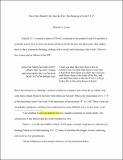Out of the (model) city, into the fire : the meaning of Ezek 5:3-4
Abstract
In this essay I argue, first, that Ezek 5:3 does not depict protection or the preservation of a “remnant” in which hope can be located but rather describes one punishment in a sequence of punishments (vv. 1–4a, 12). These punishments have been constructed by creatively reworking earlier legal traditions. Second, Ezek 5:1–4a, 12 should be read in light of a larger group of passages in Ezekiel that share the same argument structure: a merism depicting the destruction of Jerusalem juxtaposed with a comment about survivors. This argument is not about the possibility of survivors but rather is concerned with interpreting (and thereby controlling) the status and meaning of survivors. Third, it seems possible that Ezek 5:4b can be understood as a later redactional addition, a sentiment coordinated with other passages that constitute a critique of Israel's monarchy (in Ezekiel, of King Zedekiah in particular). On the one hand, these verses represent the prophet's attempt to interpret the disaster for his community, and, on the other, they form an essential part of his strategy of community identity formation over and against the exiles of 587 BCE.
Citation
Lyons , M A 2019 , ' Out of the (model) city, into the fire : the meaning of Ezek 5:3-4 ' , Journal of Biblical Literature , vol. 138 , no. 3 , pp. 605-623 . https://doi.org/10.15699/jbl.1383.2019.654746
Publication
Journal of Biblical Literature
Status
Peer reviewed
ISSN
0021-9231Type
Journal article
Collections
Items in the St Andrews Research Repository are protected by copyright, with all rights reserved, unless otherwise indicated.

